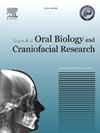Bioprinting techniques for regeneration of oral and craniofacial tissues: Current advances and future prospects
Q1 Medicine
Journal of oral biology and craniofacial research
Pub Date : 2025-02-12
DOI:10.1016/j.jobcr.2025.01.019
引用次数: 0
Abstract
Background
Regenerative dentistry aims to reinstate, fix, renew, and regrow tissues within the oral and craniofacial domain. Existing regenerative methods are based on insights into tissue biology or disease processes that lead to tissue degradation. However, achieving complete and functional Tissue regeneration remains a primary challenge in real-world medical scenarios.
Aim
The review focuses on the application of bioprinting techniques for rejuvenating intricate Oral and craniofacial tissues, such as craniofacial bone, periodontal ligament, cementum, dental pulp, temporomandibular joint cartilage, and whole teeth.
Methods
Bioprinting, a cutting-edge technology in regenerative dentistry, strives to create entirely new Functional tissues and organs. This approach merges principles from engineering and biology to produce three-dimensional biologically operational constructs containing bioactive substances, Living cells and cell clusters using automated bioprinters. The review summarizes the outcomes achieved through bioprinting techniques in both in vitro (laboratory experiments) and in vivo (Studies on living organisms) experiments.
Result
The emergence of this innovative tissue engineering technology has yielded highly promising outcomes during the experimental stages.
Conclusion
These promising experimental results necessitate replication through human clinical trials to ascertain the viability of bioprinting techniques for mainstream clinical implementation in regenerative dentistry.
口腔和颅面组织再生的生物打印技术:当前进展和未来展望
再生牙科旨在恢复、修复、更新和再生口腔和颅面区域内的组织。现有的再生方法是基于对组织生物学或导致组织降解的疾病过程的了解。然而,实现完整和功能性的组织再生仍然是现实世界医疗场景中的主要挑战。目的综述生物打印技术在颅面骨、牙周韧带、牙骨质、牙髓、颞下颌关节软骨和全牙等复杂口腔和颅面组织修复中的应用。方法生物打印技术是再生牙科领域的一项前沿技术,致力于创造全新的功能组织和器官。这种方法结合了工程学和生物学的原理,使用自动生物打印机生产含有生物活性物质、活细胞和细胞团的三维生物操作结构。综述了生物打印技术在体外(实验室实验)和体内(生物体研究)两方面取得的成果。结果这一创新的组织工程技术的出现在实验阶段取得了非常有希望的结果。结论这些有希望的实验结果需要通过人体临床试验来复制,以确定生物打印技术在再生牙科主流临床应用的可行性。
本文章由计算机程序翻译,如有差异,请以英文原文为准。
求助全文
约1分钟内获得全文
求助全文
来源期刊

Journal of oral biology and craniofacial research
Medicine-Otorhinolaryngology
CiteScore
4.90
自引率
0.00%
发文量
133
审稿时长
167 days
期刊介绍:
Journal of Oral Biology and Craniofacial Research (JOBCR)is the official journal of the Craniofacial Research Foundation (CRF). The journal aims to provide a common platform for both clinical and translational research and to promote interdisciplinary sciences in craniofacial region. JOBCR publishes content that includes diseases, injuries and defects in the head, neck, face, jaws and the hard and soft tissues of the mouth and jaws and face region; diagnosis and medical management of diseases specific to the orofacial tissues and of oral manifestations of systemic diseases; studies on identifying populations at risk of oral disease or in need of specific care, and comparing regional, environmental, social, and access similarities and differences in dental care between populations; diseases of the mouth and related structures like salivary glands, temporomandibular joints, facial muscles and perioral skin; biomedical engineering, tissue engineering and stem cells. The journal publishes reviews, commentaries, peer-reviewed original research articles, short communication, and case reports.
 求助内容:
求助内容: 应助结果提醒方式:
应助结果提醒方式:


